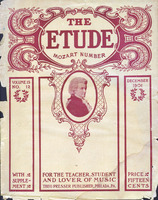BY H. A. CLARKE.
It may seem rather late in the day to discuss the “Art of Mozart,” but, in view of the fact that there is a large and growing class who flippantly dismiss Mozart as old-fashioned or antiquated, it will do no harm, and perhaps may result in good, to devote some study to the phase of music that is presented in the work of Mozart. How to judge of Mozart’s art. To estimate aright the work of Mozart, it is, before all, necessary to take into consideration the time in which he lived: it was a time of rapid growth in the art, the impulse of which is not yet ended; at the same time, the traditions of the old classical school still exercised their sway over the minds of musicians. The harmonic freedom that has since grown up was only beginning; such was also the case with the technical command of all or nearly all musical instruments on the part of their players; last, the “form,” made familiar in the symphony and in chamber-music was still waiting the transforming touch of Beethoven to release it from the rigidity it had so soon acquired, and give it a wider scope and a fuller, elastic life.
Recognizing to the fullest extent the above conditions will guide us to look aright, without the expectation of finding either the freedom or intensity of Beethoven or of succeeding writers.
THE PREDOMINANT QUALITIES OF MOZART’S MUSIC.
The first quality of Mozart’s music to claim attention is the beauty and refinement of his melody. Beauty and refinement are, indeed, the chief characteristics of his work; yet it would be a great mistake to think that strength is excluded by these qualities; were this lacking, the former qualities would soon pall. In Mozart’s music the balance is so perfectly preserved that his work might be described as the most perfect illustration of artistic sanity. Another striking characteristic of his music is its apparent transparency and simplicity; truly, only apparent, as the careful student will soon discover. Again, in no other music is such a fine discrimination (for want of a better word) manifested in the weaving together of the sounds, never one too few or too many, never one that might be displaced without marring the perfect plan. The texture of a Mozart quartet is like that of those wonderful gauzes made in India. A Beethoven quartet is like a cloth of gold, fit for royal wear, but the other might clothe angels.
Another striking characteristic of this music is the “Art that Conceals Art”; its effect is such that the merest tyro can enjoy, yet its contexture is such that the most learned musician can only wonder and admire.
WHERE MOZART’S BEST WORK IS FOUND.
It is an axiom that judgment of any man’s work should be based on the best he has done, as even “Homer may nod” and Mozart may not always have done the best of which he was capable. Those who know Mozart only through his piano-sonatas are not in a position to judge of his greatness. He was a harpsichordist, and the technic of this obsolete instrument was vastly different to that of the piano, and, although the piano was a familiar instrument with him before he died, he never was able to free himself completely from his early training on the harpsichord, and consequently could never get himself in sympathy with the instrument sufficiently to understand its capabilities; hence many weary pages of “Alberti bass’ in his sonatas. In short, it may be admitted that, in comparison with the later piano-sonatas of Haydn, those of Dussek, and those of his pupil, Hummel, they seem almost archaic. Yet even in these there are movements of absolutely perfect beauty, and in one, the “C-minor Fantasie and Sonata,” a depth of meaning that even Beethoven has not surpassed. To the world at large Mozart is better known as the writer of operas than in any other capacity. Great as these undoubtedly are, they are not such a measure of his greatness as his symphonies, and—at the risk of expressing a bold opinion—his symphonies are not such a measure as his chamber-music. The string quartet and quintet seemed to furnish the right medium for the expression of that delicacy and refinement, that inimitable mixture of simplicity and profundity, that are his chief characteristics.
In the realm of music these quartets and quintets stand alone, as the representative of purest beauty allied with matchless skill. But, with these quartets as a theme, one might write volumes of rhapsodies; better is it to stop, with this advice to all who would know how beautiful music may be: learn to play a string instrument and play these quartets until their absolute perfection has produced its due effect. Then are you safe from all the extravagant vagaries that have resulted from the latter-day mad striving after originality.



